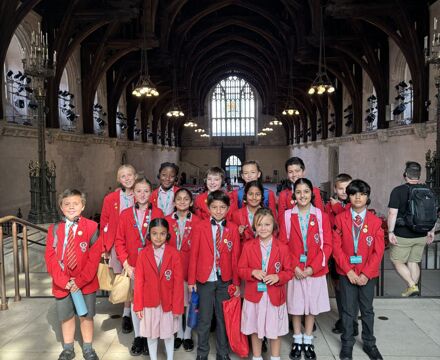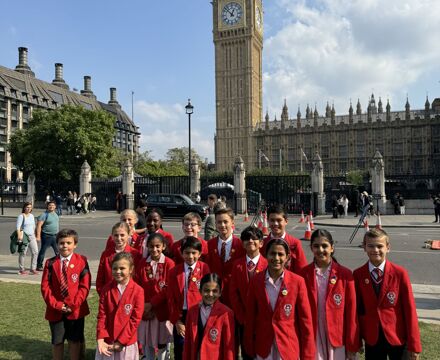- Home
- News & Events
- News Blog
- WGPS School Council and Visit to Parliam...
News Blog
WGPS School Council and Visit to Parliament
Posted on: 25th Sep 2024
At WGPS, we value the ideas and opinions of our pupils. This is one way in which the “pupil voice” is heard. We welcome a space where suggestions are brought forward, debated, and appropriate actions are taken.
Each year, a new WGPS School Council is democratically peer-elected. This process ensures that each class from Year 2 upwards is represented by a child their classmates have chosen. The School Council provides a platform where each pupil (through the class representative) has the opportunity to become an active decision-maker in the wider school community.
The School Council meets regularly (once a half term) to discuss matters relevant to and raised by the respective classes' representatives. Mr Lechmere-Smith chairs the School Council; however, in January, after all the 11+ preparation, the Year 6 Head Girl and Head Boy will chair the meeting with the Pupil Leadership Team in attendance.
Once the School Council is elected, we take them to the epicentre of democracy, the Houses of Parliament. On Friday, 20 September 2024, the School Council had a fantastic morning visiting The Palace of Westminster.
Our day started with visiting the UK Parliament Education Centre, where we briefly met a real-life Baroness. We watched a video explaining how the Magna Carta was signed by King John in 1215 and, subsequently, the House of Lords, the House of Commons, and Parliament were formed. Did you know that Parliament derives from the French word ‘parle’, which means ‘to speak’? We also briefly learned about the very important Suffragette movement that campaigned and successfully got the right for women to vote in the UK.
After the video, we had a guided tour where we entered the House of Parliament through the Sovereign’s Entrance. We stood in the Robing room, where a copy of the Magna Carta was displayed along with Queen Victoria’s seat. We continued through the Houses of Parliament and saw both the House of Lords and the House of Commons. Even though there were no MPs (as they were on a two-week recess), we were still not allowed to sit on the benches. We learned how members of the House of Commons are elected and how members of the House of Lords are selected. It wasn’t until 1999 that the House of Lords Act abolished the automatic right of hereditary peers to sit in the House of Lords.
We enjoyed a lovely picnic in front of Big Ben (did you know that Big Ben is not the official name of the famous landmark. Big Ben is the nickname given to the Great Bell inside the Elizabeth Tower) before we returned to WGPS.
It was an excellent opportunity for our pupils, giving them an insight into the workings of the British government. Our pupils were definitely inspired by what they saw on their visit and returned to school with a greater understanding of the importance of democracy and its impact on our lives.
Mr Lechmere-Smith
We crossed the road from Westminster tube station to the Houses of Parliament and walked for 10 minutes to the entrance. The security guards checked our bags, a Baroness bumped into us and then walked away, busy doing her duties, and then we met our tour guide. We walked on old wooden floors through long corridors, brightly lit by large windows, to a cinema room (showing a video about the interesting history of the building), and then into the Victoria Tower. The part of the tower we went to was called the Sovereign's Entrance, which the King uses as a parking space when he comes for his annual visit. Not even the Prime Minister gets to go in there.
Up a famous flight of stairs called the Norman Porch, we entered a red velvet-carpeted room with pictures of Queen Victoria in her robing room. A short chair that Victoria sat on was placed at the end of the room. This is where she made her speeches. Onwards to where the 650 members of each party did their work. A famous portrait of Horatio Nelson (known for his naval victories, including at the Battle of Trafalgar) hung on the wall of the office. Then to the red-coated House of Lords (the smaller party). A huge golden throne meant for the monarch was placed in the centre of about seven rows of seats. Debating happened here.
On to the House of Commons, where there was a turquoise cloth covering a room. When the House was bombed, former Prime Minister Winston Churchill decided that when debating happened, only 427 people from a party could fit in the room, not the full 650 members. Finally, to round up this fabulous trip, we went into a long, narrow corridor which contained thick green books. These books were the writings of journalists copying down, word for word, what the judge in the debating room said.
6M Pupil
I was very fortunate to visit Parliament, where decisions which impact the country are made. When we arrived, we watched an interesting film about Parliament and how it was built. First, we saw the House of Lords, which is made up of appointed members. Members are not elected; instead, they are chosen based on their expertise, experience, or through inheritance. While we were there, our tour guide told us a bit about Queen Victoria and the secret rooms, which only the royal family knows about.
Next, we went to the House of Commons, which is responsible for creating laws. The House of Commons has more power in the process as it can propose, debate, and has the final say on money bills. We were also told that in the olden days, if debates went on for 15-16 hours and someone needed the toilet, they would pull out a bucket from under the chair and pull down a curtain to go. People would stamp their feet so they wouldn’t hear the person using the bucket!
As we moved on, we saw many old pictures of battles, kings, and queens. Lastly, we visited a 1,000-year-old room that looked like a lunch hall, and it reminded me of the Great Hall from Harry Potter. At the very end, our tour guide told us a joke. He asked, "Which side of my tie will roll down faster, the shorter one or the longer one?" And guess what he said? "It was a tie!" Get it—a tie!
I had an amazing time at Parliament and hope to go again. It was great!
6M Pupil






